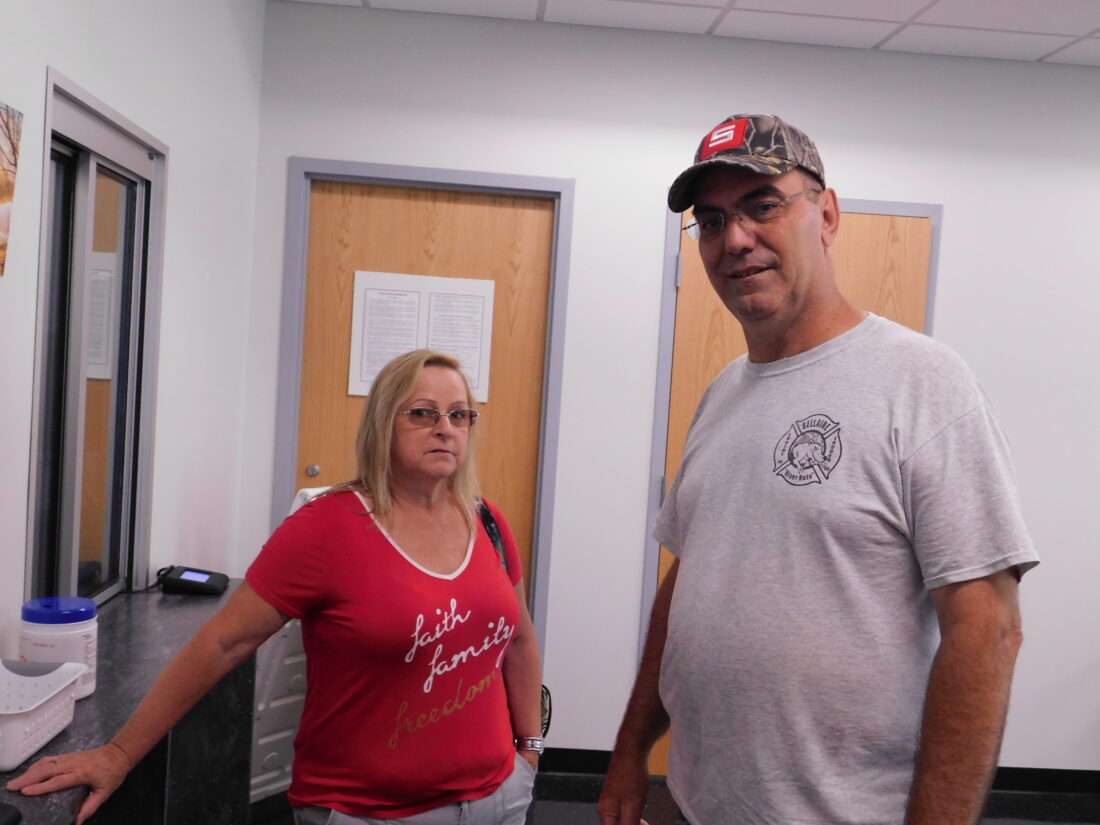Ohioans weigh in on Issue 1

T-L Photo/ROBERT A. DEFRANK Jerrilyn, left, and John Lee of Bellaire stop by the Belmont County Board of Elections office Thursday to pick up their ballots. They intend to research State Issue 1 before casting their votes.
ST. CLAIRSVILLE — Ohio voters will decide the fate of future state constitutional amendments in the Aug. 8 special election.
The single issue on the ballot is a proposal to increase the number of votes required to amend the Ohio Constitution, requiring 60 percent of the vote rather than the simple majority of 50 percent plus one vote. Petition signatures would also be required to come from all 88 counties to place an amendment on the ballot, rather than the current 44 counties.
On Thursday, the central committee of the Belmont County Republican Party officially endorsed Issue 1. Bob Blinco, a member of the committee, said this measure will protect the state constitution from being too easily changed, adding that the current more than 50 percent requirement makes the document vulnerable to “outside forces.”
“Some of our fellow citizens have been confused about Issue 1 due to advertisements by out-of-state special interest and extremist groups funded by large conglomerates and large unions that do not properly represent or respect their rank and file membership,” a states a news release from the party, which went on to state that Ohioans have consistently passed amendments to the state constitution with a much higher percentage of the vote than required. It notes that of the 156 amendments proposed since 1913, 42 percent have had at least 60 percent of the vote, and only 27 percent passed with just over 50 percent.
The Ohio Democratic Party has officially opposed Issue 1. Locally, Phil Wallace of the Belmont County Democrats Central Committee, said the Belmont County Democrats are opposed to the issuem as well.
There is a proposed amendment to the Ohio Constitution, The Right to Reproductive Freedom with Protections for Health and Safety, on the Nov. 7 election ballot.
“I think people are just overreacting on a lot of stuff,” Wallace said. “Some people think this has to do with abortion and all that kind of stuff. It’s more than that.”
He added that Issue 1 would place an unnecessary burden on efforts to change the constitution.
“It would take 60 percent, which is a real issue to deal with, because 60 percent sometimes in a small election is not favorable to pass,” Wallace said.
He said a rally in opposition to Issue 1 is set for 10:30 a.m. July 21 at the St. Clairsville Recreation Center.
Meanwhile, Blinco pointed out that amendments become permanent parts of the constitution.
“Whether you’re coming at it from a conservative or liberal point of view, if you want something put in the constitution of Ohio, you’ve got to live with that decision,” Blinco said. “It shouldn’t be something where you get half the vote plus one … and that decides it for the rest. … When you pass an amendment to the constitution, you want it to be as strong as possible and supported by as many people as possible.”
He said Issue 1 would guarantee a voice for rural Ohioans when sway might otherwise be dominated by large urban areas.
“We cannot outspend the big cities, and we cannot outspend the big organizations and the big unions,” he said. “I want to take away any possibility that anybody can buy those few votes. This gives us a cushion.”
Rick Smathers, president of the Upper Ohio Valley Central Labor Council, said amendments to the constitution will still occur, but Issue 1 would place a barrier for genuine grassroots movements while not stymying large corporations.
“I don’t think the minority should make a decision for the majority of the people. I think the 50-plus-one is the way it’s been. That’s democracy. That’s the way it should stay,” he said. “The minority could choose to make it a right-to-work state with a constitutional amendment. Collective bargaining for public sectors. There’s just a multitude of issues that could come up that they could try to put an amendment on. … It could affect women’s rights, reproductive rights.”
Smathers also questioned the decision to present the issue to voters in August, when historically there is low voter turnout.
“Plus it only requires 50 percent plus one. It doesn’t require the 60 percent to pass,” he said of the issue. “It’s an assault on the public.”
Mark McVey, member of the labor council, said Issue 1 would give 40 percent of the voters control of 100 percent of state issues. He recalled the 2011 defeat of a proposed collective bargaining law that many believed would be restrictive. McVey said it was defeated by more than 60 percent of the vote.
“But that rarely happens,” he said. “An initiative is usually in the 50-something, 40-something. … What we’re concerned about is if they do impose Right to Work and we wanted to put it on the ballot as an initiative to see what the whole state felt, we would have to get 60 percent of the vote. That may happen, but it may not, and it would be much harder to stop something like Right to Work, or even school funding. Any initiative that the people may want to put on the ballot, the majority should speak and not the so-called supermajority. Not just labor, every voter in Ohio should be concerned about that.”
Ohio Rep. Don Jones, R-Freeport, is in favor of Issue 1.
“In my opinion, it should not be easy to change our state constitution. To change the U.S. Constitution takes 60 percent, so why would we not want (that) to change our state constitution?”
Jones believes the need to gather signatures from all 88 counties will benefit rural areas.
“That’s something that’s important to me, because so many times Eastern and Southeastern Ohio, Appalachia gets left out of a lot of these issues, because they don’t want to spend any time, listen to our opinion or gather any signatures here,” Jones said.
“There are a lot of issues coming down the pike, so to speak, pertaining to constitutional amendments,” he said. “The issue might be abortion today, tomorrow it might be recreational marijuana. The next day it could be animal agriculture. It could be a minimum wage requirement. We’ve got to be aware of the fact that whenever we start changing our state constitution and putting things in there, they need to be issues that are overwhelmingly supported. … I don’t want to see us turn into a state where we have out-of-state interests and money dictating what we do and don’t do in the state of Ohio, and that’s why we’re giving Ohioans an opportunity to decide.
“I would just encourage all voters to educate themselves. Reach out to myself or their state representative or their state senator,” Jones said.
Ohio Rep. Ron Ferguson, R-Wintersville, agreed.
“In a constitutional republic we should protect our constitution,” he said. “Nearly all of the constitutional amendments that signatures are gathered for and put on the ballot come from special interests, whether it’s something you support or something you oppose, it’s very heavily funded, well-oiled businesses that pay signature-gatherers from outside our state to come to our state to get these things on the ballot. … We want to make sure our constitution is set up and governed by Ohioans.”
Ferguson said majority rule would continue for ballot initiatives, referendums and common laws.
He also sees the 88-county requirement as a protective measure for rural voices.
“If it’s a true Ohio-led citizen initiative, if Ohioans want it, it shouldn’t be very difficult to find some people in every single county that want it,” he said. “It should block out those big money interests and really not be a hindrance to citizen-let ballot initiatives.”
Michael Curtin, an independent former journalist from Columbus who has been active in opposing Issue 1, takes a historical perspective, saying the current method was established in 1912 during a time of extreme corruption and passed by both parties and resulted in initiative and referendum powers for voters.
He said Issue 1 is a “dilution, a watering down, a weakening of a constitutional right.”
“It’s unprecedented on many levels,” he said. “(Ohio voters) have used those powers responsibly.”
Curtin went on to point out that several amendments such as allowing African-Americans and women into the National Guard did not pass with 60 percent of the vote.
“A 60 percent barrier … would make it nearly impossible to update the constitution when it needs to be updated. It needs to be a living document, and a 60 percent threshold, quite frankly, would prevent Ohioans from keeping their constitution changing with the times,” Curtin said.
“A lot of people are making it about abortion, or they’re making it about guns or they’re making it about the minimum wage or they’re making it about other issues, but none of those things are on the ballot,” he said. “There’s only one thing on the ballot, and that’s your constitutional right to qualify an amendment for the ballot.”
No staff members were available to discuss early voting in the Aug. 8 election at the Belmont County Board of Elections office toward the end of the day on Friday, but John and Jerrilyn Lee of Bellaire stopped in to pick up absentee ballots. They said they are undecided until they further research the issue.
“We definitely need to read what it’s all about,” John Lee said. “I’m of the impression if it’s not broke, don’t fix it, but that’s only my opinion.”
Early voting is 8 a.m. to 5 p.m. Monday-Friday July 17-28; 7:30 a.m. to 7:30 p.m. July 31; 7:30 a.m. to 8:30 p.m. Aug. 1; 7:30 a.m. to 7:30 p.m. Aug 2-4; 8 a.m. to 4 p.m. Aug. 5, and 1-5 p.m. Aug. 6.
The board of elections office is at 52180 National Road East, St Clairsville.


